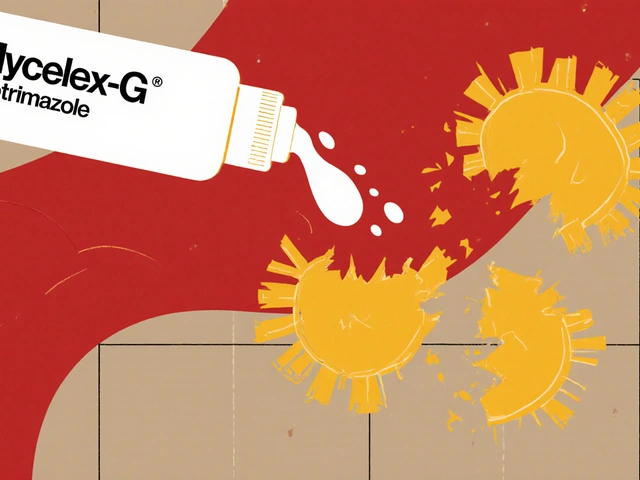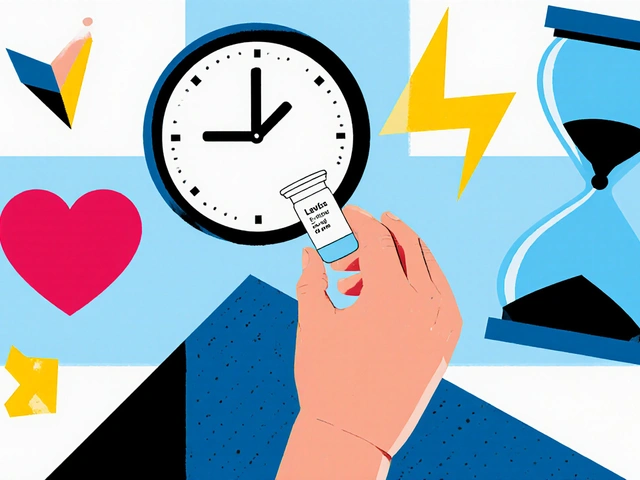PAD Medication Choice Advisor
This tool helps identify the most suitable medication for treating intermittent claudication based on your health status and preferences.
When doctors treat intermittent claudication - the leg pain that pops up after a short walk - they often reach for Pletal a prescription drug whose active ingredient is Cilostazol. It’s been on the market for over two decades, but it’s not the only game in town. This guide walks you through how Pletal works, where it shines, where it stumbles, and which other options might fit your lifestyle better.
Quick Take
- Pletal improves walking distance by 30‑50% in most patients with peripheral artery disease (PAD).
- Common side‑effects include headache, diarrhea, and a slight rise in heart rate.
- Key oral alternatives are Pentoxifylline a blood‑flow enhancer that works differently from Cilostazol and Naftidrofuryl a vasodilator popular in Europe.
- Intravenous options like Iloprost a prostacyclin analogue used for severe PAD are reserved for critical cases.
- Non‑drug approaches - supervised exercise programs and smoking cessation - deliver comparable or better outcomes when combined with medication.
How Pletal (Cilostazol) Works
Cilostazol belongs to the phosphodiesterase‑3 (PDE‑3) inhibitor class. By blocking this enzyme, it raises cyclic‑AMP levels in blood‑vessel walls, which leads to two useful effects:
- Vasodilation: arteries relax, allowing more oxygen‑rich blood to reach the muscles.
- Platelet inhibition: blood clots are less likely to form, reducing the chance of a sudden blockage.
Clinical trials published in the early 2000s showed a mean increase of 45 metres in maximal walking distance after 12 weeks of therapy. The drug is taken twice daily, usually with food to lessen stomach upset.
Key Benefits and Risks of Pletal
Benefits
- Improves pain‑free walking time for the majority of PAD patients.
- Convenient oral dosing - no clinic visits for IV infusions.
- Can be combined with antiplatelet agents like aspirin, provided cardiac function is normal.
Risks & Contra‑indications
- Not for patients with heart failure (NYHA Class III/IV) - it can worsen fluid retention.
- Common side‑effects: headache, dyspepsia, diarrhea, and a modest increase in heart rate.
- Rare but serious: severe hypotension or bleeding when mixed with other anticoagulants.
Because it affects platelet function, doctors advise a wash‑out period before any surgical procedure.
Top Oral Alternatives
When Pletal isn’t tolerated or is contraindicated, clinicians turn to other drugs that also aim to boost blood flow.
Pentoxifylline
Pentoxifylline a methyl‑xanthine derivative that makes blood cells more flexible improves microcirculation by reducing blood viscosity. Typical dose: 400mg three times daily.
- Effectiveness: modest - average walking distance increases 15‑25%.
- Side‑effects: nausea, flushing, dizziness.
- Benefit: safe for mild heart failure patients.
Naftidrofuryl
Naftidrofuryl a vasodilator that works on peripheral alpha‑adrenergic receptors is widely used in Europe and Canada. The usual regimen is 150mg twice daily.
- Effectiveness: similar to Pentoxifylline, with some studies showing up to 30% improvement.
- Side‑effects: mild abdominal pain, occasional rash.
- Interaction profile: low, making it a good option with statins.

Intravenous and Advanced Options
For patients with critical limb ischemia or those who cannot take oral meds, consider the following.
Iloprost
Iloprost a synthetic analog of prostacyclin given by continuous IV infusion dilates small vessels and inhibits platelet aggregation. Doses range from 0.5 to 2ng/kg/min for 6‑12hours daily over 2‑4 weeks.
- Effectiveness: can restore foot perfusion enough to avoid amputation in 60‑70% of severe cases.
- Side‑effects: headache, hypotension, flushing, rare bleeding.
- Practical note: requires hospital monitoring, so cost and logistics are higher.
Non‑Drug Strategies That Matter
Medication alone rarely cures claudication. Pairing drugs with lifestyle changes yields the best outcomes.
- Supervised Exercise Therapy (SET): 30‑60minutes of walking three times a week improves walking distance by up to 200m - often more than any single drug.
- Smoking Cessation: quits reduce disease progression by 30% and improve drug efficacy.
- Statin Therapy: lowers cholesterol and stabilizes plaques, indirectly supporting blood flow.
Side‑by‑Side Comparison
| Attribute | Pletal (Cilostazol) | Pentoxifylline | Naftidrofuryl | Iloprost (IV) |
|---|---|---|---|---|
| Mechanism | PDE‑3 inhibition → vasodilation + platelet inhibition | Rheologic effect → reduces blood viscosity | Alpha‑adrenergic blockade → peripheral vasodilation | Prostacyclin analog → micro‑vascular dilation |
| Typical dose | 100mg twice daily | 400mg three times daily | 150mg twice daily | 0.5‑2ng/kg/min infusion |
| Walking distance ↑ | 30‑50% | 15‑25% | 20‑30% | 60‑80% (severe cases) |
| Major side‑effects | Headache, diarrhea, tachycardia | Nausea, flushing | Abdominal discomfort | Hypotension, headache |
| Contra‑indicated in | Heart failure (NYHA III/IV) | Severe hepatic impairment | Uncontrolled hypertension | Active bleeding, severe hypotension |
| Cost (US, 2025) | $150/month (generic) | $90/month (generic) | $120/month (brand) | $2,500 for 2‑week course |
Choosing the Right Option for You
The best therapy depends on three personal factors: cardiac health, tolerance for side‑effects, and willingness to engage in supervised exercise.
- If you have normal heart function and can handle occasional headaches, Pletal is usually the first choice because it offers the biggest boost in walking distance for a modest price.
- If you’ve been flagged for heart failure or experience palpitations on Pletal, switch to Pentoxifylline - it’s safer for compromised cardiac output.
- When you’re in Europe or Canada and your insurance prefers locally‑approved drugs, Naftidrofuryl may be the most accessible.
- For critical limb ischemia, amputations looming, or when oral medicines have failed, discuss Iloprost with a vascular specialist.
Never underestimate the power of a structured walking program. Even a modest 20‑minute daily session, supervised by a physiotherapist, can amplify any drug’s effect by 20‑30%.
Frequently Asked Questions
Can I take Pletal if I have high blood pressure?
Yes, Pletal does not raise blood pressure. In fact, its vasodilating action can slightly lower systolic numbers, but you should still monitor your BP regularly.
How long does it take to notice improvement?
Most patients report a perceptible increase in pain‑free walking distance after 4‑6 weeks of consistent dosing, with maximal benefit around 12 weeks.
Is it safe to combine Pletal with aspirin?
Combining the two is common practice; they work on different pathways. Just ensure your doctor checks for any bleeding risk, especially if you’re on other anticoagulants.
What if I miss a dose?
Take the missed tablet as soon as you remember, unless it’s almost time for the next dose. Never double‑dose to catch up.
Are there natural supplements that work as well?
Some botanicals (e.g., ginkgo biloba, hawthorn) show mild vasodilatory effects, but robust trials are lacking. They can complement, not replace, proven medications.
Bottom line: Pletal remains a solid first‑line pill for intermittent claudication, but alternatives like Pentoxifylline, Naftidrofuryl, or Iloprost fill the gaps when heart health, side‑effect tolerance, or disease severity demand a different approach. Pair any drug with regular walking and smoking cessation, and you’ll give your legs the best chance to stay pain‑free.







Liliana Lawrence
September 28, 2025 AT 22:03Sharmita Datta
September 29, 2025 AT 23:54mona gabriel
September 30, 2025 AT 08:13Phillip Gerringer
October 1, 2025 AT 16:18jeff melvin
October 2, 2025 AT 03:48Stephen Wark
October 2, 2025 AT 23:35Daniel McKnight
October 4, 2025 AT 01:02Jaylen Baker
October 4, 2025 AT 14:23Fiona Hoxhaj
October 5, 2025 AT 14:25Merlin Maria
October 5, 2025 AT 15:38Nagamani Thaviti
October 6, 2025 AT 01:06Kamal Virk
October 8, 2025 AT 00:33angie leblanc
October 8, 2025 AT 23:11LaMaya Edmonds
October 9, 2025 AT 12:10See Lo
October 11, 2025 AT 00:18Chris Long
October 12, 2025 AT 03:38mona gabriel
October 12, 2025 AT 04:43